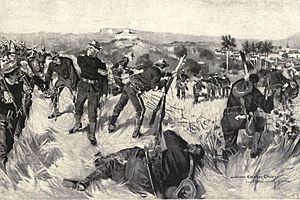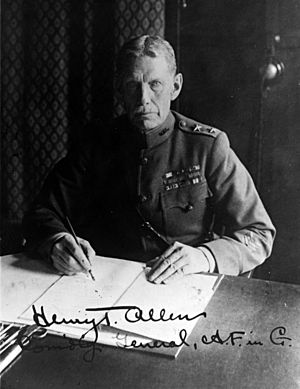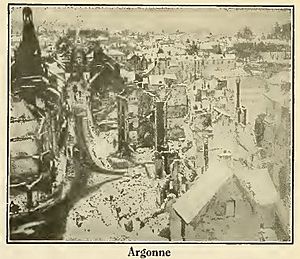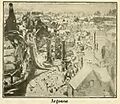Henry Tureman Allen facts for kids
Quick facts for kids
Henry Tureman Allen
|
|
|---|---|
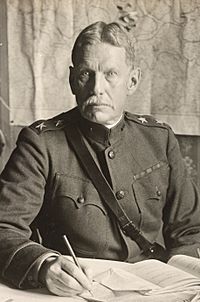
Henry Allen in January 1919
|
|
| Nickname(s) | "Iron Commandante" |
| Born | April 13, 1859 Sharpsburg, Kentucky, United States |
| Died | August 29, 1930 (aged 71) Buena Vista, Pennsylvania, United States |
| Buried | |
| Allegiance | |
| Service/ |
|
| Years of service | 1882–1923 |
| Rank | |
| Unit | |
| Commands held | 2nd Cavalry Regiment 8th Cavalry Regiment 90th Infantry Division |
| Battles/wars | Spanish–American War
|
| Awards | Distinguished Service Medal |
Major General Henry Tureman Allen (born April 13, 1859 – died August 29, 1930) was a brave United States Army officer. He was famous for exploring the wild lands of Alaska in 1885. He traveled over 1,500 miles (2,400 km) through untouched wilderness.
His amazing journey explored the Copper River, Tanana River, and Koyukuk River. General Nelson A. Miles even compared his adventure to the famous Lewis and Clark Expedition.
Henry Allen was born in Sharpsburg, Kentucky. He finished his studies at the United States Military Academy in 1882. He then became a second lieutenant in the cavalry. He worked for General Nelson A. Miles and later served as a military expert in Russia and Germany. Allen also fought in the Spanish–American War at the Battle of El Caney.
Later, Allen went to the Philippines. He became the military governor of Leyte in 1901. He also helped create and lead the Philippine Constabulary. This was a police force that helped keep peace on the islands. In 1904, he observed the Japanese Army in Korea. During World War I, he led the 90th Infantry Division.
Contents
Henry Allen's Life and Adventures
Early Years and Military Training
Henry Allen was born on April 13, 1859, in Sharpsburg, Kentucky. He was one of fourteen children. After attending military school, he went to Georgetown College. He graduated in 1878.
He then joined the United States Military Academy at West Point. In 1882, he graduated and became a cavalry officer. From 1888 to 1890, Allen taught at West Point. He also served in the American Old West, protecting the Northern Pacific Railroad.
Exploring Alaska's Wilderness
Allen was very excited to serve in Alaska in 1884. He wrote that he wanted to explore the wild lands there. At the time, he was a lieutenant working for General Nelson A. Miles.
Miles sent Allen to find Lieutenant William R. Abercrombie. Abercrombie had tried to explore the Copper River but faced tough glaciers and land. Allen found him near the river's mouth.
Allen then planned to explore the Copper and Tanana rivers. These were two of Alaska's largest uncharted rivers. General Miles approved his plan. Allen insisted on a small team of three men, including himself.
In the spring of 1885, Allen, Sgt. Cady Robertson, and Pvt. Fred Fickett arrived at the Copper River Delta. They planned to travel the Copper River on ice. They faced freezing rain and difficult land.
An Indian named John Bremner joined them later. Even with low supplies, Allen explored the Chitina River. This was a major branch of the Copper River. He learned to build and use skin boats like the local people.
They traveled upriver, often running low on food. Sometimes, they had to eat "rotten, wormy meat." After getting new guides, they left the Copper River. They crossed into the Alaska Range through a pass Allen named Miles Pass.
They were the first to map this rugged river and high mountain range. When two men got sick, Allen changed his plan. He headed to a trading post on the Tanana River. This post was over 560 miles (900 km) away.
They passed through lands thought to be home to unfriendly natives. But Allen found the natives were only interested in his medicine. In just five months, Allen explored about 1,500 miles (2,400 km) of unknown wilderness. General Miles said Allen's trip was the greatest exploration since Lewis and Clark.
Fighting in the Spanish-American War and Philippines
When the Spanish–American War started in April 1898, Allen left Germany. By June 1898, he led Troop D of the 2nd Cavalry Regiment. He became a major and went to Cuba.
He and his men served as scouts and guards during the Santiago Land Campaign. They fought bravely on July 1, 1898, in the Battle of El Caney. On July 10, Allen took control of the town. It held over 20,000 refugees.
There was not enough food or medicine. But a disaster was avoided when Santiago de Cuba surrendered. This allowed the refugees to go home. Allen then got sick and had to return to the United States. His service was highly praised by Theodore Roosevelt.
In 1898, Allen became a captain in the regular army. He returned to Berlin, Germany. But he wanted to fight again. In 1899, he transferred to the 43rd volunteer Regiment as a major. He led the 3rd Battalion on the island of Samar in the Philippines.
He successfully recruited members for the Philippine Scouts. He also fought against local rebels. After peace came to Samar, Allen commanded a section of Leyte. He treated the local people fairly. He even started projects to improve Leyte.
Allen made sure the laws of war were followed strictly. He became known as "Iron Commandante" to the locals. This was because he was strict but also fair and kind.
Allen briefly served as governor of Leyte in 1901. After this, he was chosen to create the Philippine Constabulary. This group filled the gap between American soldiers and Filipino police. It had Filipino police and American officers.
The Constabulary helped stop the rebellion. It guarded prisons, gathered information, and brought law and order back. Allen led this group until 1907. He became a temporary brigadier general, commanding over 10,000 men.
World War I and Beyond
Allen returned to the United States in 1907. He joined the General Staff in 1910 as a cavalry expert. In 1912, he became a lieutenant colonel. In 1916, he became a colonel. He led the 8th Cavalry Regiment. They served in the Punitive Expedition, where General John J. Pershing tried to capture Pancho Villa.
After the United States joined World War I, Allen was promoted to brigadier general in May 1917. He became a temporary major general. He was given command of the 90th Infantry Division in Texas. This unit had many new soldiers from Oklahoma and Texas.
The division had many shortages, like rifles and uniforms. But Allen kept his men in a strong training program. In May 1918, the division was sent to the Western Front in France. Allen made his men train for fifteen hours a day. In June, they sailed to France.
After more training, the 90th Infantry Division entered the front lines on August 24. This was near the St. Mihiel salient. General Pershing, now the top commander, planned his first major attack there. Allen's unit was key to this attack.
The attack began on September 12. Allen's men moved forward and captured their goals. By September 16, the Americans had won. After this, Pershing planned another attack at Meuse-Argonne. Allen's unit joined the battle later.
The 90th advanced slowly. Allen replaced officers who were not performing well. The division crossed the Meuse River just days before the war ended. The Armistice of November 11, 1918, stopped the fighting.
After the war, Pershing made Allen commander of American Forces in Germany in July 1919. From 1919 to 1923, Allen was a military governor. He oversaw the American zone of occupation around Coblenz. He also worked to protect American interests. He often tried to limit French plans in the region.
Later Life and Legacy
Allen became a permanent major general in 1923 and retired that same year. He lived in Washington D.C. He wrote two books about his time in Germany: My Rhineland Journal (1923) and The Rhineland Occupation (1927). He also spoke about world politics and joined the Democratic Party.
After leaving Germany, Allen started a campaign to help Germany. In 1923, he led the American Committee for Relief of German Children. This group gave extra meals to hungry children and mothers. The campaign raised $4.3 million. At its peak, it fed one million German children.
Allen also served as a leader for the American Olympic Committee during the 1924 Summer Olympics. In 1928, he was considered for Vice President of the United States. He died on August 29, 1930, in Pennsylvania. He was buried in Arlington National Cemetery. General Pershing was one of the people who carried his coffin.
Personal Life and Honors
Henry Tureman Allen married Dora Johnston (1860–1932) on July 12, 1887. They had three children: Jeanette, Henry Jr., and Daria. Jeanette married Lt General Frank Maxwell Andrews, after whom Andrews Air Force Base was named. General Allen also loved polo.
Camp Allen, the first home of the Philippine Military Academy, is named after him. In 1941, a U.S. Navy ship was renamed Henry T. Allen. The Alaskan geologist, Alfred Hulse Brooks, said that "No man through his own individual explorations has added more to our knowledge of Alaska than Lieutenant Allen." The town of Allen, Northern Samar in the Philippines is also named in his honor.
Images for kids
-
The destruction seen in Argonne Forest, France from the Meuse-Argonne Offensive.


